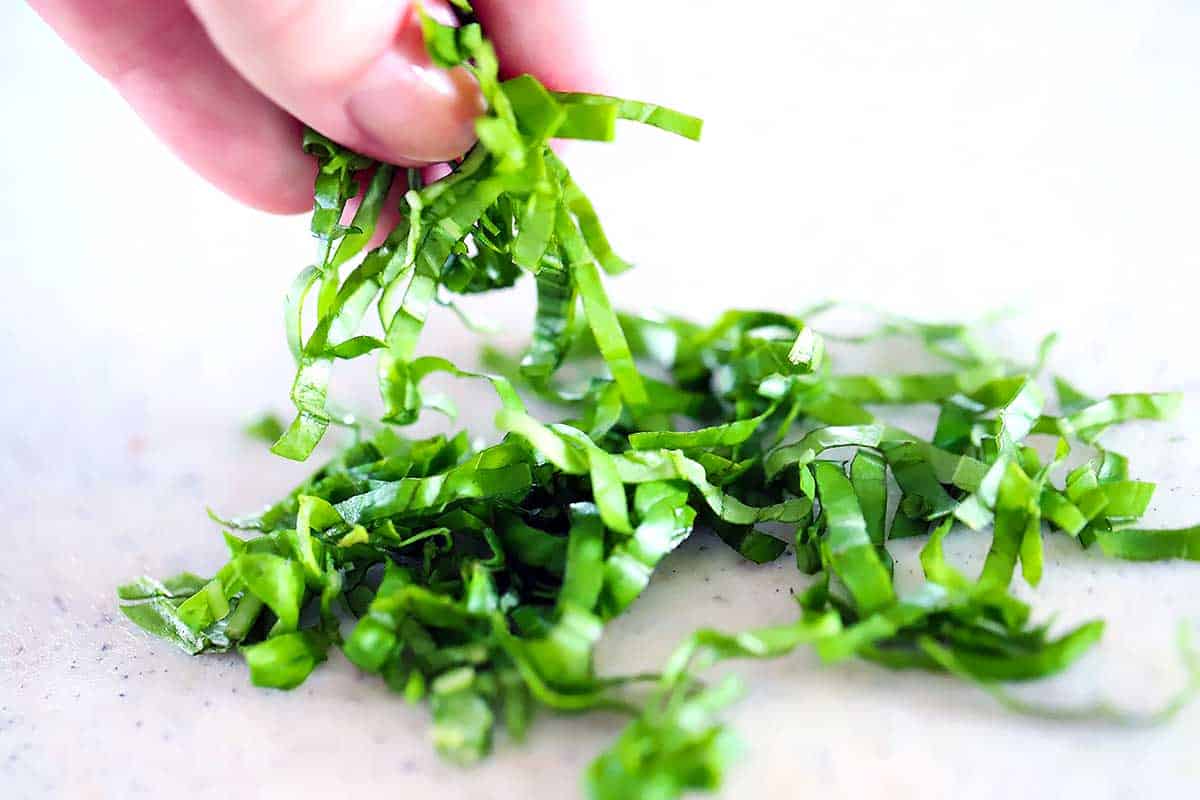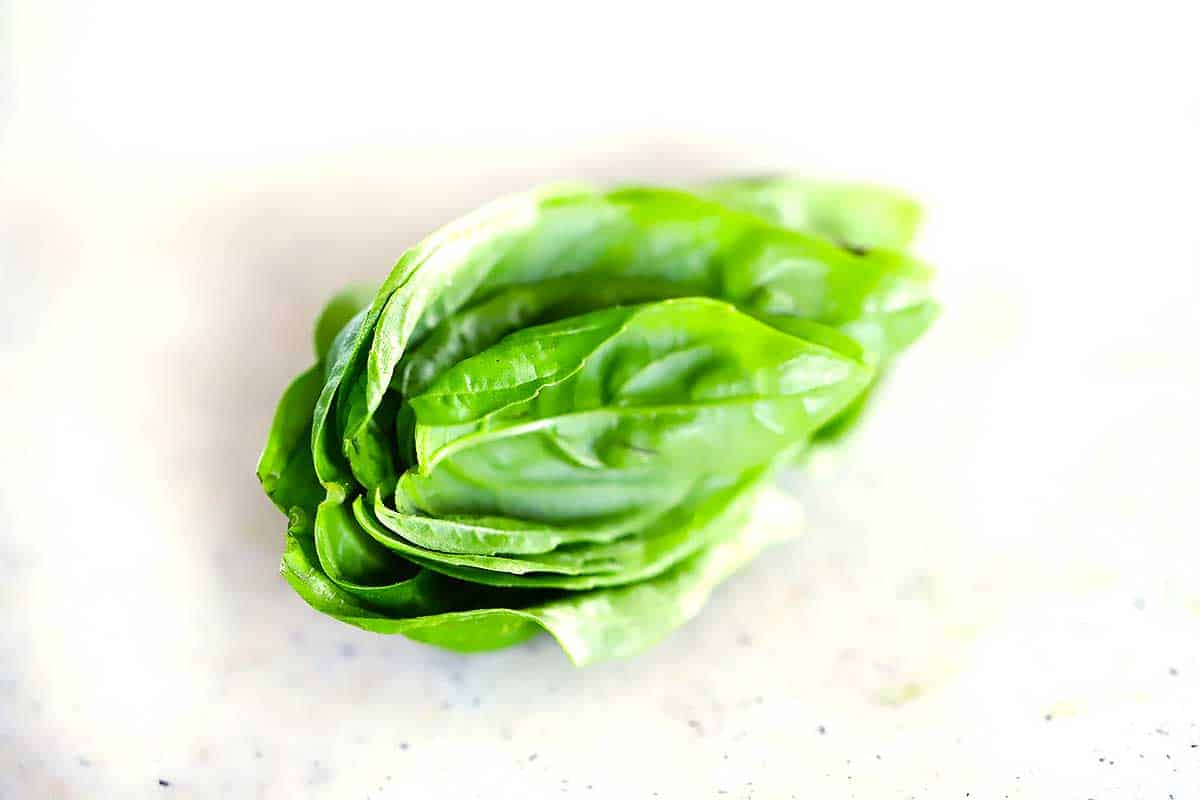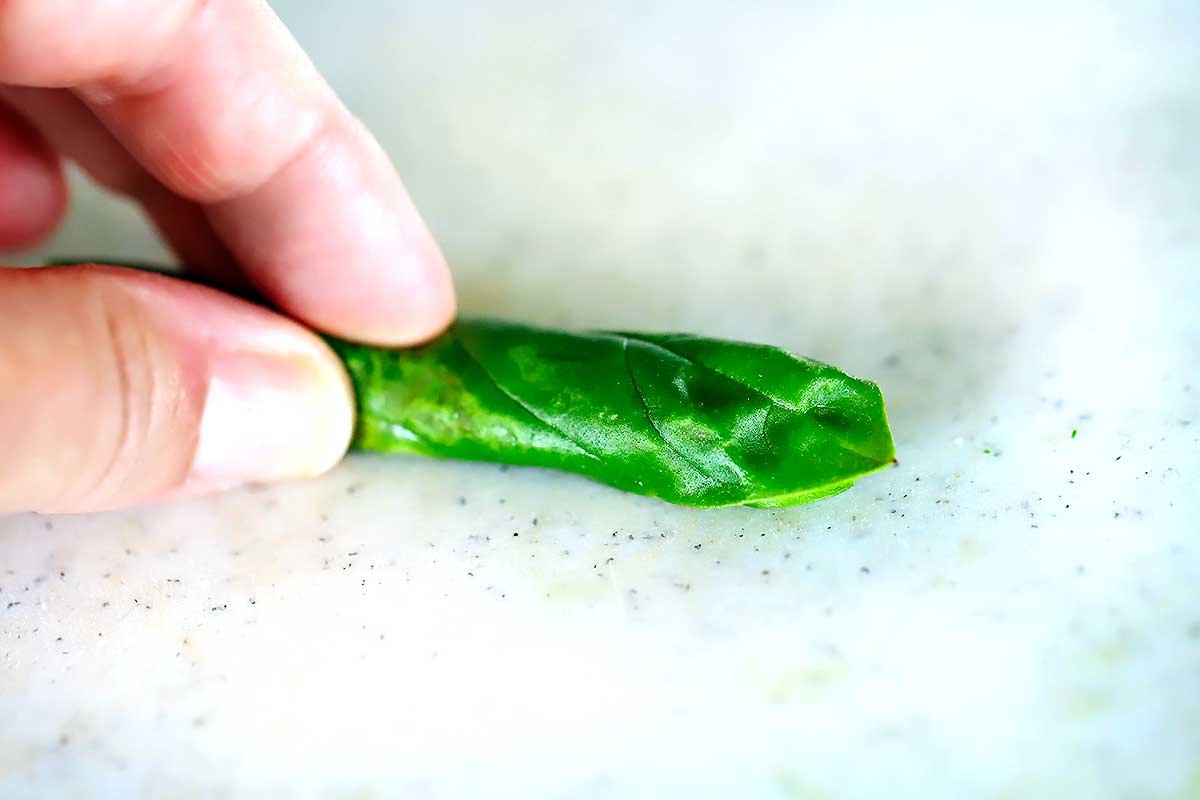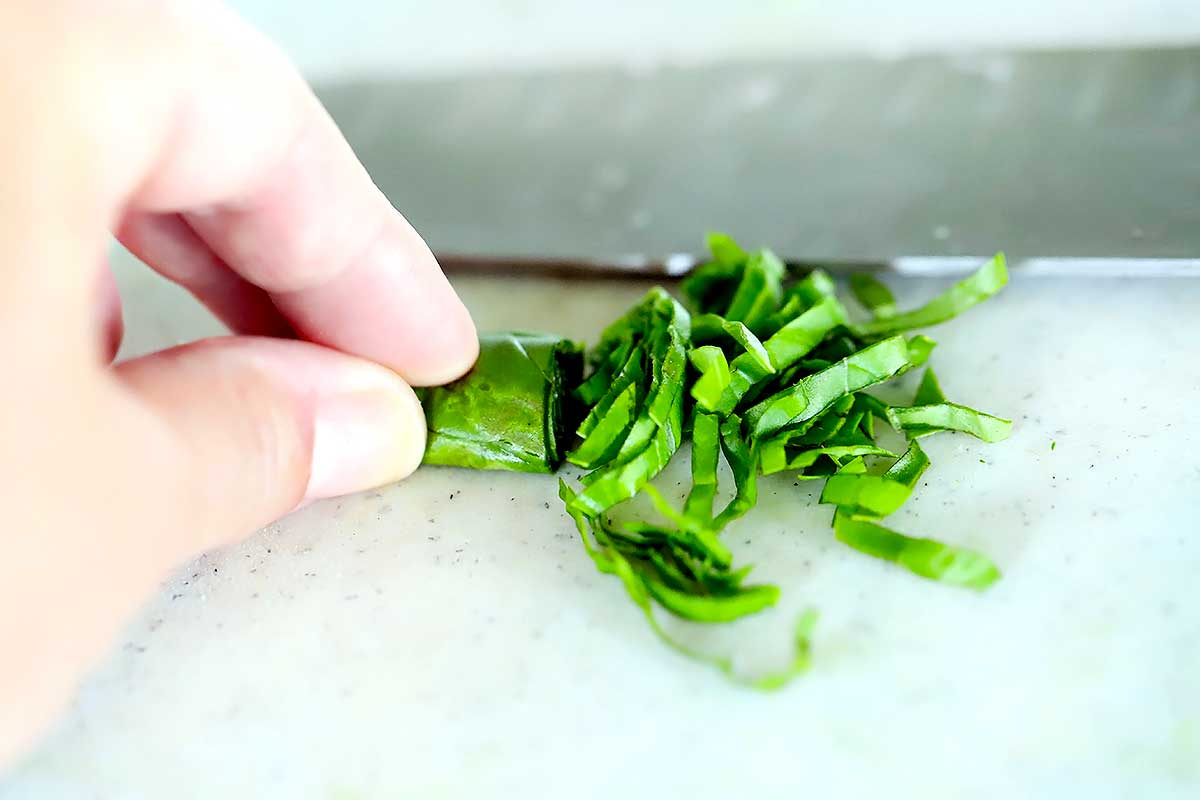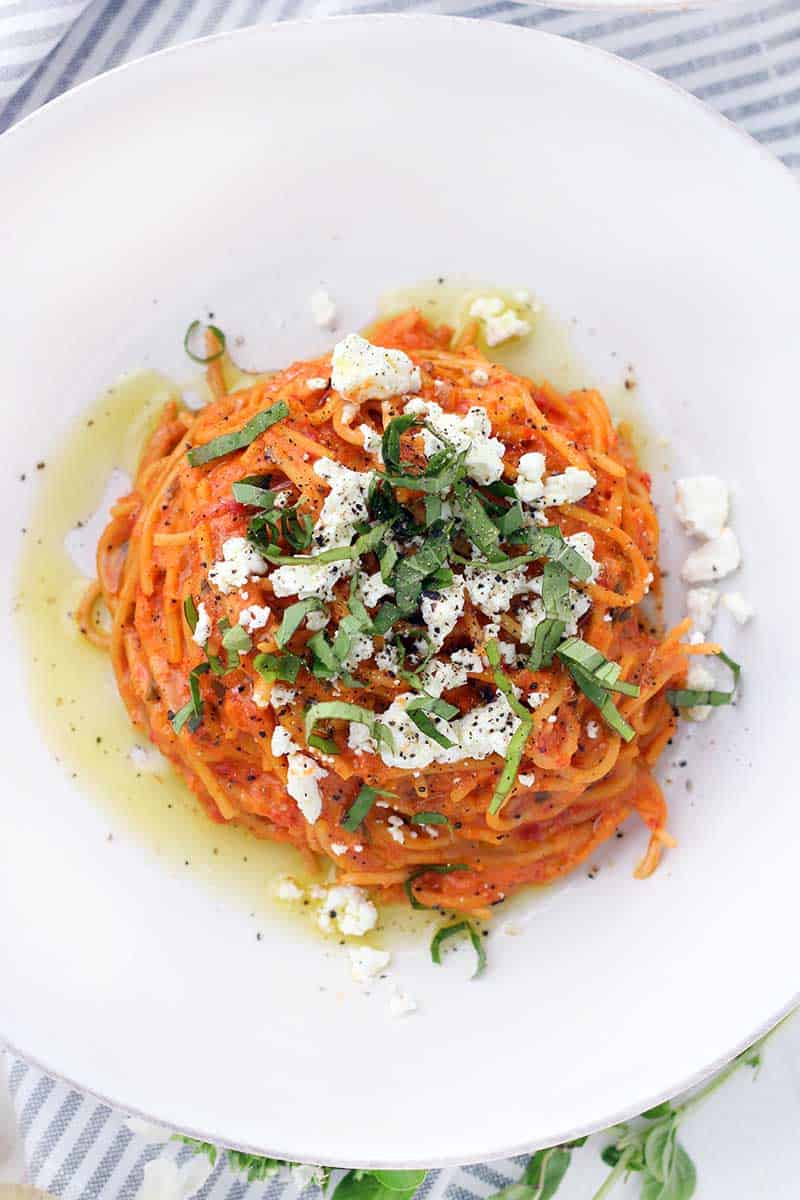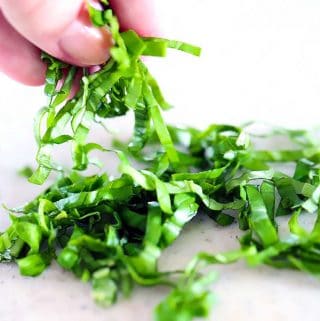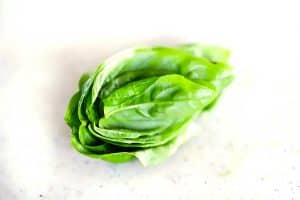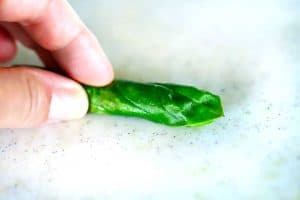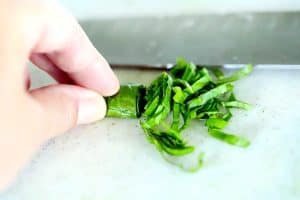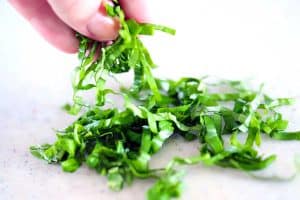When a recipe calls for a “chiffonade of basil,” it’s easy to think it’s too complicated and not to bother. But I want you to know: it’s NOT as fancy as it sounds, it’s SUPER easy (easier than regular chopping!), and will make a simple recipe feel beautiful and fancy! You can use the chiffonade (pronounced two ways: shif-uh–neyd, or shif-uh-nahd, meaning “little ribbons” in French) technique for other herbs, as well as leafy greens or other ingredients. In this post, I’ll explain exactly HOW to cut a chiffonade of basil in SECONDS, why chiffonade works so well for basil, what other herbs and ingredients you can use the cutting technique for, and give you some recipe recommendations that would be great with chiffonade-cut basil!
How to cut a chiffonade!
I know I’m using a lot of exclamation points in this post, but I really geek out over cooking techniques like this- those that require so little effort and take a simple ingredient to the next level. And it seriously takes almost NO effort- in a matter of SECONDS you’ll have a gorgeous chiffonade! It’s as simple as: stack, roll, and slice. Here’s how.
Step 1: Stack the leaves from big to small, face-down.
Layer the basil leaves, with the stems removed, with the largest leaves on the bottom and the smallest leaves on the top. Stack them so they curl upward- the “tops” of the leaves should face down.
Step 2: Roll the leaves tightly.
Starting on one of the long ends, roll the leaves as tightly as you can. Hold the roll firmly with your non-dominant hand (I’m right-handed, so I held it with my left hand). Don’t worry TOO much about getting it SUPER tight, but you want it to be tight enough to stay together easily when you slice it.
Step 3: Slice the roll thinly.
Using your best, sharpest chef’s knife, work your way from one end to the other, making sure to keep holding onto the roll so it stays together until the very end. Be CAREFUL! Go slowly, so you can make sure you get thin slices- about 1/8″ max, and so you make sure to keep the hand that’s holding it safe. I also recommend using the bottom part of your knife– the part closest to the handle- to cut. You’ll have more control, and it’s often the sharpest part of the knife.
Step 4: Separate the ribbons!
You’re now done cutting the chiffonade! Gently separate the ribbons of basil (or whatever you’re cutting). They’re now ready to use as a garnish or almost anywhere you need to use fresh basil!
Why does chiffonade work so well for basil?
It takes mere seconds to cut a chiffonade of basil and it’s by far the easiest and fastest way to cut the herb. But there are other advantages too! Here’s why it’s the best technique for cutting basil.
You won’t bruise the leaves. If you’ve worked with basil or mint a lot, you may notice that if you are rough with them, they’ll turn bruised and brown colored. This isn’t as appetizing for a garnish. Chiffonade requires very little rough handling, like chopping, and the leaves generally stay bright green and beautiful. You can cut the leaves when they’re a little wet. You don’t want it soaking wet- give it a little shake or pat with a towel first. But have you ever tried washing basil and then going to chop it right away? You generally end up with leaves stuck to your knife and cutting board, and the bottom layer never cuts through all the way (resulting in bruising!). Rolling the basil gives you a thick thing to cut through, making your knife work so much better even if the leaves are wet. The pieces are the perfect size for the flavor. For basil, you generally want to use pieces that are large enough to get a great punch of flavor, but not large enough that it overpowers. The little thin strips of basil that result from a chiffonade cut are the perfect size for this. Even though a whole leaf is more traditional in caprese salad, I prefer chiffonade basil for this reason. That way, you can get as much or as little as you want without worrying about chowing down on a whole leaf! I like using it in cooked sauces and soups as well for this same reason– even though it gets cooked down and won’t be as pretty, it’s a great way to distribute the flavor of the basil easily.
Using mint, sage, spinach, and other ingredients for a chiffonade
You can use the chiffonade knife technique to cut many things other than basil. Here are some examples, but you can basically do it to anything that you can stack, roll, and slice!
Other broad-leaf herbs, such as mint (like on this dessert pizza) or sage (like on this roasted butternut squash). Leafy greens, such as spinach (as a garnish on soup or in pasta primavera) lettuce (like in this chiffonade salad) or collard greens (cooked or raw), or kale (like in this salad). You can even chiffonade non-plants, like eggs! (like in this colorful salad recipe).
The chiffonade is not well-suited to ingredients that are very small (such as parsley or cilantro) or too thick to stack and roll (like slices of carrots).
Try using a chiffonade of basil in these recipes:
Spaghetti with Roasted Red Pepper Sauce and Goat Cheese (pictured above) Caprese Pasta Salad with Creamy Balsamic Dressing Oven Baked Goat Cheese Balls with Fresh Basil and Honey Chicken and Broccoli Linguine with Lemon Butter Basil Sauce Spaghetti with Burrata and Veggies Lasagna Soup Panzanella Salad (from The Pioneer Woman)
Got any questions? What’s your favorite way to use chiffonade-cut basil, or other ingredients? Add a comment below!
